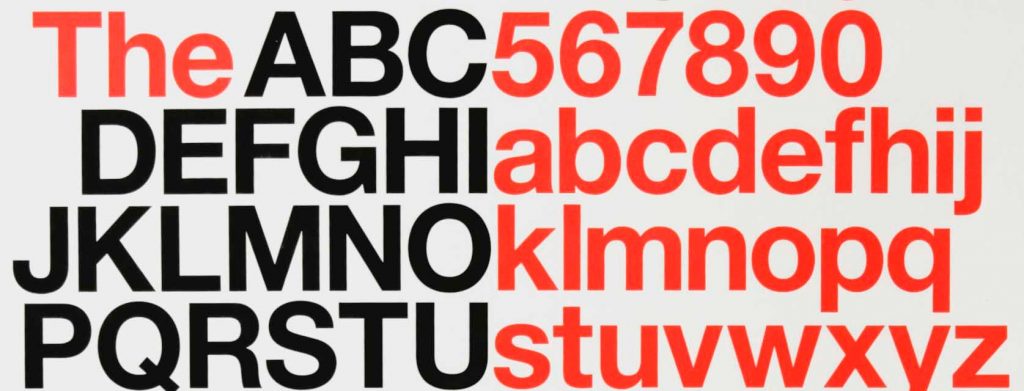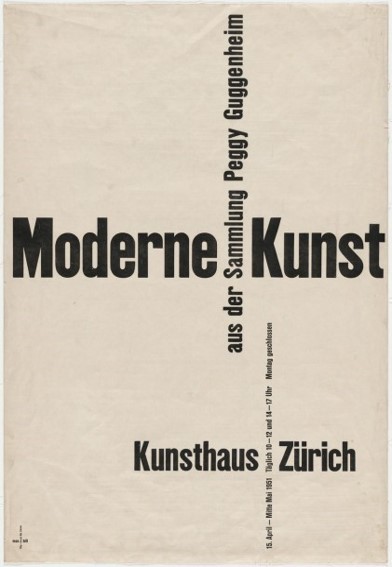
What you should know about Swiss style graphic design

Swiss style graphic design, which is also often referred to as International Typographic Style or International Style, is a design movement which emerged during the 1950’s in Switzerland.
It is more than likely you encounter and engage with Swiss style graphic design every day. Ever since its emergence it has arguably become the most important and prevalent graphic design style of the twentieth century. It has spread throughout the world and continues to inspire artists and designers every single day.
The History
The first graphic design schools were established in the 19th century as the Applied Arts began to strive to distinguish themselves from the Fine Arts. The desire for the independence of design was strongest in German-speaking countries across Europe. This was especially true for Switzerland, who remained neutral during the second world war. Due to Switzerland’s neutrality it became a haven for intellectuals, as well as became a meeting point for ideas from many different places, such as Holland, Russia, Germany, and England.
The movement of Swiss style graphic design began at two Swiss schools. The first being Kunstgewerbeschule in Zurich. This art and design institute was led by the influential Josef Müller-Brockmann. The second school involved in the development of Swiss style graphic design was Allgemeine Gewerbeschule in Basel, which was led by Armin Hofmann.
Students at these schools were never forced to adopt a certain style but instead a respect for content through simplicity was encouraged. This became the birth of Swiss style graphic design – inspired by the modernist ideal of form following function.
Swiss style graphic design’s development was also a reaction to the ongoing Arts and Crafts movement in England and the Jugendstil (Youth Style) movement in Germany. Both theses preceding styles were very intricate, illustrative and rich in patterns and flourishes. These movements aimed to exalt the designer or artist involved which is what Swiss style graphic design rejects entirely. It instead embraces the modern and the anonymity achieved by machine-based design.
Many prior art movements are known to also have had major influence on the development of Swiss style graphic design – serving as a source of inspiration in achieving a new minimalistic and mathematical approach. The intersection of design and art during 1914 and 1939 was a major source of inspiration for Swiss style designers. The art of Suprematism and Constructivism in Russia, De Stijl in the Netherlands, and the Constructivism-inspired work of the Bauhaus in Germany became the building blocks in developing the Swiss style.
The simplified, geometric shapes and bold, sans-serif typography used in unusual formations found in the art of the suprematists and constructivists became a main source of inspiration. Swiss style graphic design also borrowed De Stijl’s principles of mathematical grid forms as compositional tools. The geometric shapes, sans serif typography and grid organization iconic of the Bauhaus style also became major elements in Swiss style graphic design and the development thereof.

Works by Josef Müller-Brockmann/ Images from Design History
The Swiss Style
Many of the characteristics of Swiss style graphic design have become so prevalent in current design they are no longer thought of as distinctly Swiss – a true testament to how influential and commonplace this style has become.
Swiss style graphic design has many specific visual characteristics which shape and define the style. These include using asymmetrical layouts constructed on a mathematical grid; a clear and minimal presentation of content; sans-serif type set flush-left; and a photography over illustration preference.
The primary and most influential works of Swiss style were developed into posters as they were seen as the most effective means of communication. Their iconic crisp, blocky layouts, sans-serif typography, and minimalist design style stemmed from the desire for design to be as invisible as possible. Swiss style graphic design revolves around using less, and so the removal of as many elements as possible is encouraged to emphasize only the necessary within the design.
The goal of Swiss style graphic design is for the “content” of the design to stand out. This is achieved by supressing the designer’s subjectivity and instead favouring simplicity, legibility and objectivity.
This suppression of subjectivity was often achieved through the use of grids and mathematical systems. Grid systems allow for the organisation of data and aid in the placement of elements in meaningful and logical ways while creating well-structured and balanced designs.
Precision, attention to detail, technical training, and a high standard of craft and printing were revered traits of Swiss style graphic design. These traits are what gives Swiss style graphic design its noticeably clean, crisp and concise look – which has ensured the longevity of this classic, timeless style.

Works by Josef Müller-Brockmann/Images from Design History
The Typefaces and Typography
Swiss style graphic design is devoted to the minimal elements of design, such as layout and typography, rather than textures or illustration. Swiss style graphic designers therefore pay a lot of attention to type as it one of the most fundamental elements in visually delivering a message in a precise and clear way.
The Swiss style movement sees the addition of an element, prior to exploring the potential of the fundamental ones, as a waste. Basic design elements, such as type, are seen as possessing enough aesthetic potential, with the addition of any other visuals and graphics rarely needed.
Clear, refined, and inventive lettering and typography was the desire of Swiss style graphic designers. A distinct feature of Swiss style graphic design is the bold use of sans-serif typefaces. Swiss style graphic designers turned to sans-serif typefaces for their clarity, simplicity, and universality.
Swiss style graphic design advocates that a typeface should be unobtrusive in expression. Rather, font-size is used to provide visual impact and hierarchy. By removing any flourishes and embellishments, the design is able to be read and studied rather than seen and admired.
Like the overarching goal of the Swiss style, the typefaces designed for and used in Swiss style graphic design eliminate distraction. Sans-serifs are able to be seamlessly incorporated into Swiss style graphic design as it focuses on the content and not decorative extras.
Univers
Univers is a great example of this. Created in 1954 by Adrian Frutiger, one of the 20th century’s most significant typeface designers, Univers was one of the first typefaces to form a font family. Univers is comprised of 21 individual weights and includes expanded and condensed versions. This allowed documents to use one typeface in various weights and sizes – an incredible advancement which allowed for great uniformity and simplicity in design. As such, it became hugely popular within Swiss style graphic design and is still in use today.
Helvetica
Swiss style graphic design cannot be discussed without mentioning Helvetica. The most popular sans-serif typeface in the world, Helvetica (the Latin name for Switzerland), was designed in 1957 by Eduard Hoffmann and Max Miedinger. The significance of Helvetica cannot be denied. The typeface is useful for everything and perfectly follows the Swiss style ethos and fulfils all the demands for modern type. As such, it is incredibly popular – and has even inspired a self-titled film by Gary Hustwitt to celebrate the typeface’s fiftieth birthday in 2007.

Works by Max Bill/Images from MoMA
The world was forever changed by the emergence of Swiss style graphic design. With its minimalistic use of grid and type it created striking designs with well-defined structure. It is due to this that it still holds much power and significance today.
If you are interested in contemporary Swiss posters, browse through the large selection of Ebinger Vintage Art Poster or find out more about Swiss poster galleries and museums listed on aproposter.
-by Jessica Davies-